Accepted Scientific Name: Mammillaria hybrid cv. Toumeya x knippelianus
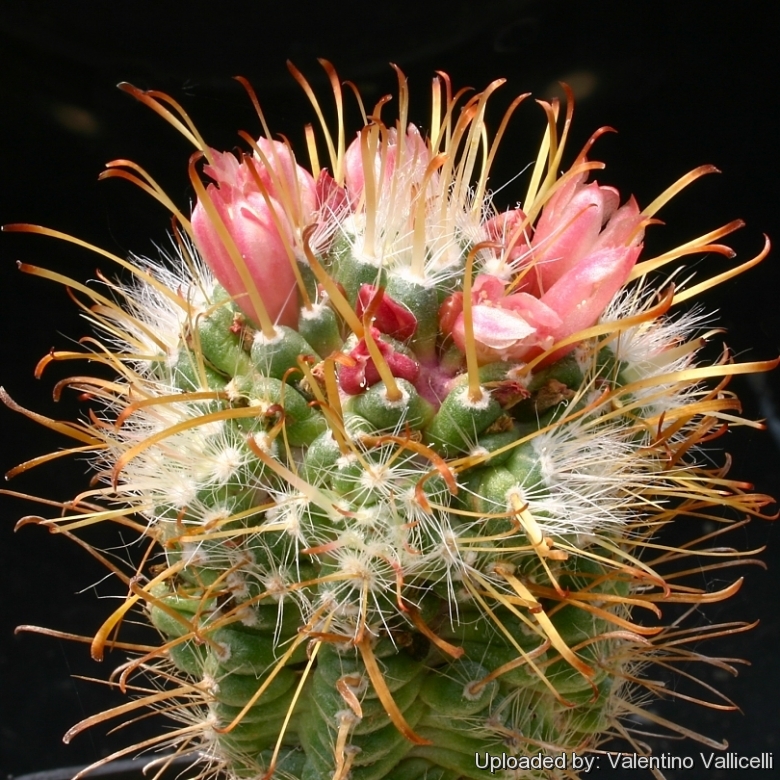
Toumeya hybrid cv. papyracantha x Echinocereus knippelianus (Mammillaria hybrid cv. Toumeya x knippelianus) Photo by: Valentino Vallicelli
This is a very odd plant with colourful flat spines.
Origin and Habitat: Garden origin ( This plant is a nursery produced cultivar, it is sometime available in the market and labelled as Toumeya papyracanthaSN|13720]]SN|13720]] x Echinocereus knippelianusSN|1580]]SN|1580]] hybrid but the true identity and origin of this hybrid is unknown)
Synonyms:
See all synonyms of Mammillaria hybrid
Description: What is this plant?
The first specimens of this unusual cactus was sold as an improbable but sticking hybrid between a Toumeya papyracanthaSN|13720]]SN|13720]] and Echinocereus knippelianusSN|1580]]SN|1580]]. However the plant is presumably a cross between a Mammillaria sp. with an unknown cactus or more likely a monstrous form of Mammillaria.
Habit: Clustering mat-forming.
Stem: 4 to 5cm wide, up to 4 cm tall, flattened and soft.
Ribs: Vertical formed by a row of elongated tubercles.
Central spines: Bright orange and yellow, flexible with a bent tip, but not hooked. They are also flat and not pungent.
Radial spines: Glassy white, bristly.
Roots: Tuberose, very juicy and pink.
Flowers: Pink in a ring around the crown.
This plant is also very similar (but not the same) to Mammillaria cv. Dolichothele x Un Pico, actually this second species has more thin, straight and longer central spines, and very few thin white radial spines per areole. Furthermore the "Toumeya papyracanthaSN|13720]]SN|13720]] x knippelianus" hybrid has characteristic swollen pink roots very different from those of the "Dolichothele x Un Pico" hybrid.
Subspecies, varieties, forms and cultivars of plants belonging to the Mammillaria cultivars group
 Mammillaria cv. Blando I.Blando: Has very odd pectinated spines, that varies in number and density depending on clones.
Mammillaria cv. Blando I.Blando: Has very odd pectinated spines, that varies in number and density depending on clones. Mammillaria cv. Caterpincy: has very reduced bristly or absent spines. It offsets from the base to form a small cluster or mound. It is very similar to: Mammillaria crinita subs. painteri f. monstruosa (if not the same)
Mammillaria cv. Caterpincy: has very reduced bristly or absent spines. It offsets from the base to form a small cluster or mound. It is very similar to: Mammillaria crinita subs. painteri f. monstruosa (if not the same) Mammillaria cv. Cettina: It shows an abnormal uncoordinated form of vegetative growth, with a multitude of condensed lateral proliferation and plant looks more like a strange furry animal than a cactus.
Mammillaria cv. Cettina: It shows an abnormal uncoordinated form of vegetative growth, with a multitude of condensed lateral proliferation and plant looks more like a strange furry animal than a cactus. Mammillaria cv. Chiara Blando I.Blando: has extremely elongated areoles, 7-20 mm long and 3-5 mm broad, which are conspicuous, in relief, densely covered with dull white felt and few tiny white bristles.
Mammillaria cv. Chiara Blando I.Blando: has extremely elongated areoles, 7-20 mm long and 3-5 mm broad, which are conspicuous, in relief, densely covered with dull white felt and few tiny white bristles. Mammillaria hybrid cv. Dolichothele x Un Pico: a supposed hybrid between a Dolichothele longimamma and Mammillaria spinosissima cv. Un Pico. It has orange and yellow central spines that are a thin, little flat, flexible but not hooked.
Mammillaria hybrid cv. Dolichothele x Un Pico: a supposed hybrid between a Dolichothele longimamma and Mammillaria spinosissima cv. Un Pico. It has orange and yellow central spines that are a thin, little flat, flexible but not hooked. Mammillaria hybrid cv. Toumeya x knippelianus: it is an improbable hybrid between a Toumeya papyracantha and Echinocereus knippelianus or more likely a monstrous form of Mammillaria. Central spines orange, flexible, flat with a bent tip.Radial spines glassy white, bristly.
Mammillaria hybrid cv. Toumeya x knippelianus: it is an improbable hybrid between a Toumeya papyracantha and Echinocereus knippelianus or more likely a monstrous form of Mammillaria. Central spines orange, flexible, flat with a bent tip.Radial spines glassy white, bristly.
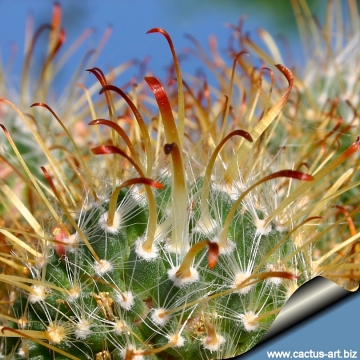 Central spines bright orange and yellow, flexible with a bent tip, but not hooked. (Mammillaria hybrid cv. Toumeya x knippelianus) Photo by: Cactus Art
Central spines bright orange and yellow, flexible with a bent tip, but not hooked. (Mammillaria hybrid cv. Toumeya x knippelianus) Photo by: Cactus Art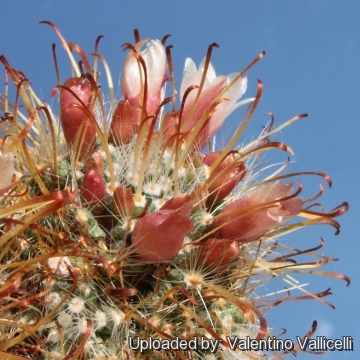 Toumeya hybrid cv. papyracantha x Echinocereus knippelianus (Mammillaria hybrid cv. Toumeya x knippelianus) Photo by: Valentino Vallicelli
Toumeya hybrid cv. papyracantha x Echinocereus knippelianus (Mammillaria hybrid cv. Toumeya x knippelianus) Photo by: Valentino Vallicelli The roots are tuberose, very juicy and pink. (Mammillaria hybrid cv. Toumeya x knippelianus) Photo by: Cactus Art
The roots are tuberose, very juicy and pink. (Mammillaria hybrid cv. Toumeya x knippelianus) Photo by: Cactus Art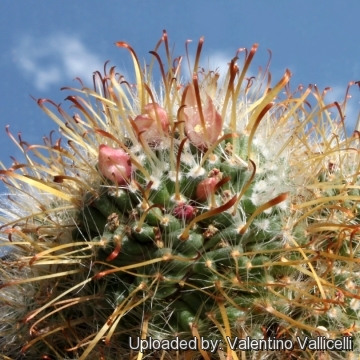 Toumeya hybrid cv. papyracantha x Echinocereus knippelianus (Mammillaria hybrid cv. Toumeya x knippelianus) Photo by: Valentino Vallicelli
Toumeya hybrid cv. papyracantha x Echinocereus knippelianus (Mammillaria hybrid cv. Toumeya x knippelianus) Photo by: Valentino Vallicelli The tubercles are characteristically disposed in vertical rib/like lines. (Mammillaria hybrid cv. Toumeya x knippelianus) Photo by: Cactus Art
The tubercles are characteristically disposed in vertical rib/like lines. (Mammillaria hybrid cv. Toumeya x knippelianus) Photo by: Cactus Art Toumeya hybrid cv. papyracantha x Echinocereus knippelianus (Mammillaria hybrid cv. Toumeya x knippelianus) Photo by: Valentino Vallicelli
Toumeya hybrid cv. papyracantha x Echinocereus knippelianus (Mammillaria hybrid cv. Toumeya x knippelianus) Photo by: Valentino Vallicelli Toumeya hybrid cv. papyracantha x Echinocereus knippelianus (Mammillaria hybrid cv. Toumeya x knippelianus) Photo by: Valentino Vallicelli
Toumeya hybrid cv. papyracantha x Echinocereus knippelianus (Mammillaria hybrid cv. Toumeya x knippelianus) Photo by: Valentino Vallicelli Toumeya hybrid cv. papyracantha x Echinocereus knippelianus (Mammillaria hybrid cv. Toumeya x knippelianus) Photo by: Valentino Vallicelli
Toumeya hybrid cv. papyracantha x Echinocereus knippelianus (Mammillaria hybrid cv. Toumeya x knippelianus) Photo by: Valentino VallicelliCultivation and Propagation: It is a species of easy culture, recommended for any collection that needs lots of light with ample airflow. Water regularly in summer, but do not overwater (very wet-sensitively, especially in light of its small root system). Water thoroughly only if soil is dry to the touch, let soil dry in between to prevent root rot, keep dry in winter.
Use a very porous mineral-based potting mix, with excellent drainage, as can be achieved by the addition of extra perlite or pumice. Feed with a high potassium fertilizer in summer. Care must be taken with watering as they tends to become swollen and untidy in growth habit if given too much water and shade. Sun Exposure: High levels of light are needed to flower and for good spine development. Can be sunburned if moved from shade/greenhouse into full sun too quickly. During the spring it may be able to take full sun until the heat arrives at the end of spring. In an area that has hot afternoon sun, it may be able to take full morning sun, but requires afternoon shade or afternoon light shade. If grown correctly, it will reward the grower with generous displays of flowers. It is quite frost resistant if kept dry, hardy as low as -5° C (or less) A resting period in winter and strong light are necessary so that it can flower properly. Clustering in cultivation and easily flowered. For best results, use a shallow pot, and only use the smallest diameter pot that will accommodate the plant. Sensitive to red spider mite. Overhead watering is helpful in controlling mites.
Propagation: Through cuttings or grafting.
Your Photos

by Valentino Vallicelli
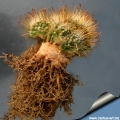
by Cactus Art

by Cactus Art

by Cactus Art






















